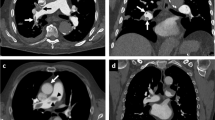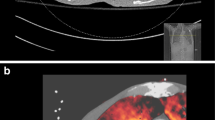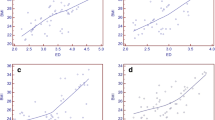Abstract
Purpose
To compare the diagnostic approach of acute pulmonary embolism (PE) with photon-counting-detector CT (PCD-CT) and energy-integrating-detector CT (EID-CT).
Materials and methods
Two cohorts underwent CT angiographic examinations with EID-CT (Group 1; n = 158) and PCD-CT (Group 2; n = 172), (b) with two options in Group 1, dual energy (Group 1a) or single energy (Group 1b) and a single option in Group 2 (spectral imaging with single source).
Results
In Group 2, all patients benefited from spectral imaging, only accessible to 105 patients (66.5%) in Group 1, with a mean acquisition time significantly shorter (0.9 ± 0.1 s vs 4.0 ± 0 .3 s; p < 0.001) and mean values of CTDIvol and DLP reduced by 46.3% and 47.7%, respectively. Comparing the quality of 70 keV (Group 2) and averaged (Group 1a) images: (a) the mean attenuation within pulmonary arteries did not differ (p = 0.13); (b) the image noise was significantly higher (p < 0.001) in Group 2 with no difference in subjective image noise (p = 0.29); and (c) 89% of examinations were devoid of artifacts in Group 2 vs 28.6% in Group 1a. The percentage of diagnostic examinations was 95.2% (100/105; Group 1a), 100% (53/53; Group 1b), and 95.3% (164/172; Group 2). There were 4.8% (5/105; Group 1a) and 4.7% (8/172; Group 2) of non-diagnostic examinations, mainly due to the suboptimal quality of vascular opacification with the restoration of a diagnostic image quality on low-energy images.
Conclusion
Compared to EID-CT, morphology and perfusion imaging were available in all patients scanned with PCD-CT, with the radiation dose reduced by 48%.
Clinical relevance statement
PCD-CT enables scanning patients with the advantages of both spectral imaging, including high-quality morphologic imaging and lung perfusion for all patients, and fast scanning—a combination that is not simultaneously accessible with EID-CT while reducing the radiation dose by almost 50%.
Key Points
-
The complementarity between morphology and perfusion imaging is accessible in each PCD-CT examination.
-
High-quality images are obtained with PCD-CT in all categories of patients, including dyspneic patients.
-
PCD-CT enables about 50% radiation dose reduction compared with EID-CT.





Similar content being viewed by others
Abbreviations
- CNR:
-
Contrast-to-noise ratio
- CTA:
-
CT angiography
- CTDIvol :
-
Volume computed tomography dose index volume
- DECT:
-
Dual energy CT
- DLP:
-
Dose-length-product
- EID-CT:
-
Energy-integrating-detector CT
- PCD-CT:
-
Photon-counting-detector CT
- PE:
-
Acute pulmonary embolism
- SNR:
-
Signal-to-noise ratio
- VMI:
-
Virtual monoenergetic imaging
References
Remy-Jardin M, Pistolesi M, Goodman LR et al (2007) Management of suspected acute pulmonary embolism in the era of CT angiography: a statement from the Fleischner Society. Radiology 245:315–332
Schoepf UJ, Costello P (2004) CT angiography for diagnosis of pulmonary embolism: state of the art. Radiology 230:329–337
Brunot S, Corneloup O, Latrabe V et al (2005) Reproducibility of multi-detector spiral computed tomography in detection of sub-segmental acute pulmonary embolism. Eur Radiol 15:2057–2063
Ghanima W, Nielssen BE, Holmen LO et al (2007) Multidetector computed tomography (MDCT) in the diagnosis of pulmonary embolism: interobserver agreement among radiologists with varied levels of experience. Acta Radiol 48:165–170
Le Gal G, Righini M, Parent F et al (2006) Diagnosis and management of subsegmental pulmonary embolism. J Thromb Haemostasis 4:724–731
Tan S, Hamarati LB, Rajiah PS et al (2022) CTA of acute pulmonary embolism: best practices. Semin Roentgenol 57:313–323
Delesalle MA, Pontana F, Duhamel A et al (2013) Spectral optimization of chest CT angiography with reduced iodine load; experience in 80 patients evaluated with dual-source, dual-energy CT. Radiology 267:256–266
Yuan R, Shuman WP, Pearls JP et al (2012) Reduced iodine load at CT pulmonary angiography with dual-energy, monochromatic imaging: comparison with standard CT pulmonary angiography—a prospective randomized trial. Radiology 262:290–297
Bae K, Jeon KN, Cho SB et al (2018) Improved opacification of a suboptimally enhanced pulmonary artery in chest CT: experience using a dual-layer detector spectral CT. AJR Am J Roentgenol 210:734–741
Zhang LJ, Chai X, Wu SY et al (2009) Detection of pulmonary embolism by dual energy CT: correlation with perfusion scintigraphy and histopathological findings in rabbits. Eur Radiol 19:2844–2854
Krissak R, Henzler T, Reichert M et al (2010) Enhanced visualization of lung vessels for diagnosis of pulmonary embolism using dual energy CT angiography. Invest Radiol 45:341–346
Lee CW, Seo JB, Song JW et al (2011) Evaluation of computer-aided detection and dual energy software in detection of peripheral pulmonary embolism on dual-energy pulmonary CT angiography. Eur Radiol 21:54–62
Apfalter P, Sudarski S, Schneider D et al (2014) Value of monoenergetic low-kV dual-energy CT datasets for improved image quality of CT pulmonary angiography. Eur J Radiol 83:322–328
Weidman EK, lodowski AJ, Halpenny DF et al (2018) Dual-energy CT angiography for the detection of pulmonary emboli: Incremental benefit of iodine maps. Radiology 289:546–553
Zhang J, Cai J, Liu S, Zhang X (2018) Value of dual-energy lung perfusion imaging using a dual-source CT system for the pulmonary embolism. Open Life Sci 13:107–111
Mao X, Wang S, Jiang X et al (2016) Diagnostic value of dual-source computerized tomography combined with perfusion imaging for peripheral pulmonary embolism. Iran J Radiol 13:e29402
Monti CB, Zanardo M, Cozzi A et al (2021) Dual-energy CT performance in acute pulmonary embolism: a meta-analysis. Eur Radiol 31:6248–6258
Abdellatif W, Ebada MA, Alkanj S et al (2021) Diagnostic accuracy of dual-energy CT in detection of acute pulmonary embolism: a systematic review and meta-analysis. Can Assoc Radiol J 72:285–292
Thieme SF, Becker CR, Hacker M et al (2008) Dual energy CT for the assessment of lung perfusion-correlation to scintigraphy. Eur J Radiol 68:369–374
Chae EJ, Seo JB, Jang YM et al (2010) Dual-energy CT for assessment of the severity of acute pulmonary embolism: pulmonary perfusion defect score compared with CT angiographic obstruction score and right ventricular/left ventricular diameter ratio. AJR Am J Roentgenol 194:604–610
Apfalter P, Bachmann V, Meyer M et al (2012) Prognostic value of perfusion defect volume at dual-energy CTA in patients with pulmonary embolism: correlation with CTA obstruction scores, CT parameters of right ventricular dysfunction and adverse clinical outcome. Eur J Radiol 81:3592–3597
Meinel F, Graef A, Bamberg F et al (2013) Effectiveness of automated quantification of pulmonary perfused blood volume using dual-energy CTPA for the severity of acute pulmonary embolism. Invest Radiol 48:563–569
Yalynska T, Polacin M, Frauenfelder T, Martini K (2022) Impact of photon-counting detector CT derived virtual monoenergetic images in the diagnosis of pulmonary embolism. Diagnostics 12:2715
Pannenbecker P, Huflage H, Grunz JP et al (2023) Photon-counting CT for diagnosis of acute pulmonary embolism: potential for contrast medium and radiation dose reduction. Eur Radiol 33:7830–7839
Pinilo J, Hutt A, Labreuche J et al (2022) Evaluation of a new reconstruction technique for dual-energy (DECT) lung perfusion: preliminary experience in 58 patients Acad Radiol 29(Suppl 2):S202–S214
Niemann T, Henry S, Faivre JB et al (2013) Clinical evaluation of automatic tube voltage selection in chest CT angiography. Eur Radiol 23:2643–2651
Hagen F, Walder L, Fritz J et al (2022) Image quality and radiation dose of contrast-enhanced chest-CT acquired on a clinical photon-counting detector CT vs second-generation dual-source CT in an oncologic cohort: preliminary results. Tomography 8:1466–1476
Thakur R, Singhal M, Aggrawal AN et al (2022) Comparison of high-pitch prospective electrocardiogram-gated pulmonary CT angiography with standard CT pulmonary angiography on dual-source CT for detection of subsegmental pulmonary embolism in patients suspected of acute pulmonary embolism. Pol J Radiol 87:e296–e303
Pannenbecker P, Heidenreich JF, Grunz JP et al (2024) Image quality and radiation dose of CTPA with iodine maps: a prospective randomized study of high-pitch mode photon-counting detector ct versus energy-integrating detector CT. AJR Am J Roentgenol 222:e2330154
Leitner D, Wichmann JL, Vogl TJ et al (2017) Virtual monoenergetic imaging and iodine perfusion maps improve diagnostic accuracy of dual-energy computed tomography pulmonary angiography with suboptimal contrast attenuation. Invest Radiol 52:659–665
Wannasopha Y, Leesmidt K, Srisuwan T et al (2022) Value of low-keV virtual monoenergetic plus dual-energy computed tomographic imaging for detection of acute pulmonary embolism. PLoS One 14:e0277060
Bach AG, Meyer HJ, Taute BM, Surov A (2016) The frequency of incidental pulmonary embolism in different CT examinations. Br J Radiol 89:20150737
Weiss J, Notohamiprodjo M et al (2017) Effect of noise-optimized monoenergetic postprocessing on diagnostic accuracy for detecting incidental pulmonary embolism in portal-venous phase dual-energy computed tomography. Invest Radiol 52:142–147
Yoo HHB, Marin FL (2020) Isolated subsegmental pulmonary embolism: current therapeutic challenges. Pol Arch Intern Med 130:986–991
Zeng Y, Geng D, Zhang J (2021) Noise-optimized virtual monoenergetic imaging technology of the third-generation dual-source computed tomography and its clinical applications. Quant Imaging Med Surg 11:4627–4643
Author information
Authors and Affiliations
Corresponding author
Ethics declarations
Guarantor
The scientific guarantor of this publication is Martine Remy-Jardin.
Conflict of interest
Two authors of this manuscript declare relationships with Siemens Healthineers (Forchheim Germany): Jacques REMY: consultant for Siemens Healthineers. Thomas Flohr: Head of the Department of Computed Tomography Research & Development, Siemens Healthineers. The remaining authors of this manuscript declare no relationships with any companies whose products or services may be related to the subject matter of the article.
Statistics and biometry
Pr Alain Duhamel, Professor Emeritus and former Head of Biostatistical Department of CHU of Lille, co-author of this study, had the necessary statistical expertise and provided statistical analyses of this manuscript.
Informed consent
Written informed consent was waived by the Institutional Review Board.
Ethical approval
Institutional Review Board approval was waived for this retrospective, non-interventional study.
Study subjects or cohorts overlap
No overlap with another study/publication.
Methodology
-
Retrospective
-
Observational
-
Performed at one institution
Additional information
Publisher’s Note Springer Nature remains neutral with regard to jurisdictional claims in published maps and institutional affiliations.
Supplementary Information
Rights and permissions
Springer Nature or its licensor (e.g. a society or other partner) holds exclusive rights to this article under a publishing agreement with the author(s) or other rightsholder(s); author self-archiving of the accepted manuscript version of this article is solely governed by the terms of such publishing agreement and applicable law.
About this article
Cite this article
Remy-Jardin, M., Oufriche, I., Guiffault, L. et al. Diagnosis of acute pulmonary embolism: when photon-counting-detector CT replaces energy-integrating-detector CT in daily routine. Eur Radiol (2024). https://doi.org/10.1007/s00330-024-10724-5
Received:
Revised:
Accepted:
Published:
DOI: https://doi.org/10.1007/s00330-024-10724-5




